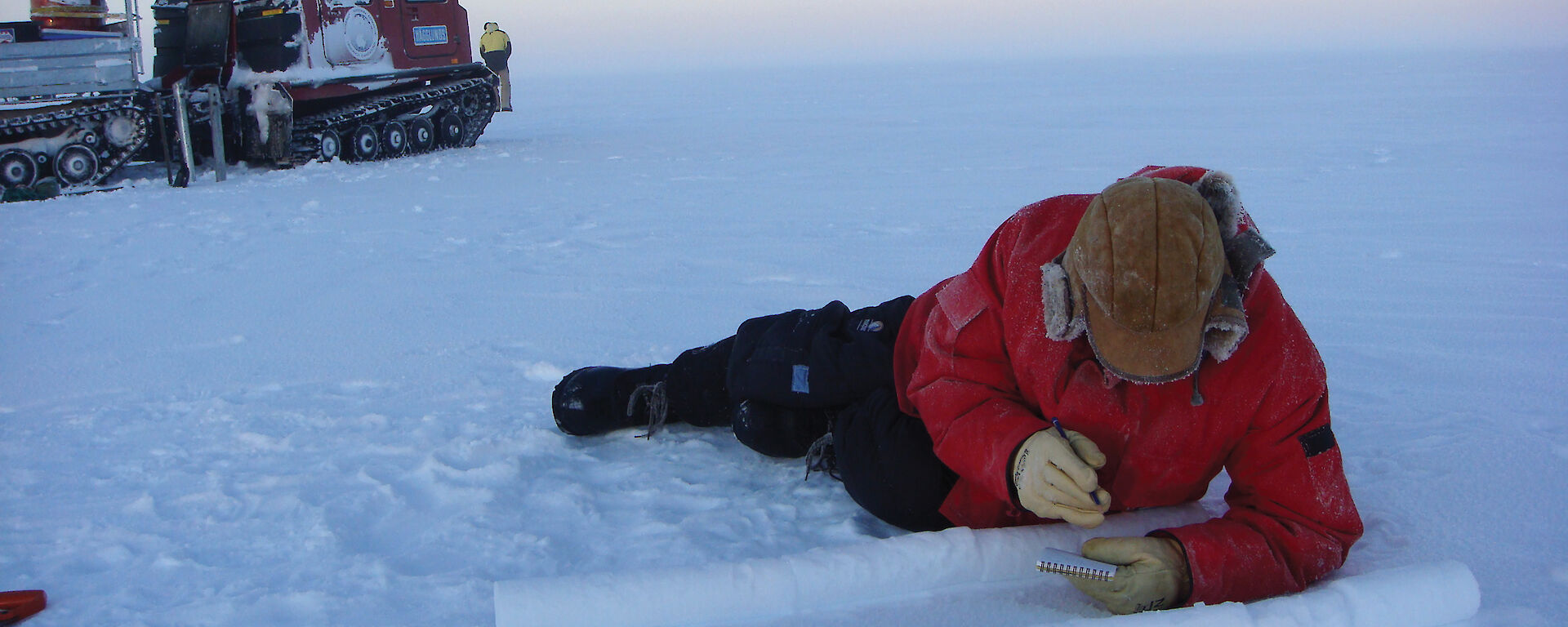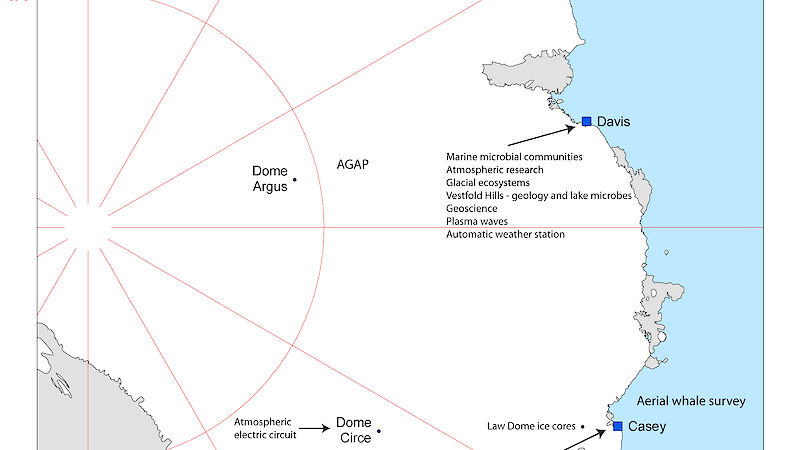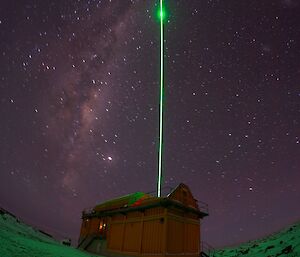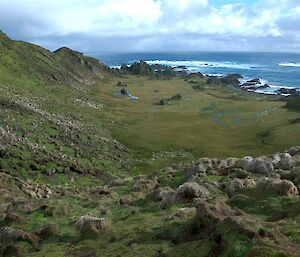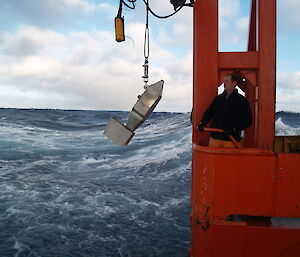A multitude of science projects will be conducted at or near each Antarctic station and Macquarie Island this season (2008–09), while some ongoing marine science will be conducted in the Southern Ocean. Download the map of the Antarctic science season 2008–2009 [PDF].
MAWSON
Adélie penguin monitoring: A long-term monitoring program of Adélie penguins is conducted at Béchervaise Island each summer to provide information required by the Commission for the Conservation of Antarctic Marine Living Resources (CCAMLR) for the sustainable management of the krill fishery.
Cosray upgrade: This year the automated cosray (cosmic ray) data collection system, installed in the 1980s, will be replaced with modern electronics. The new system can be remotely operated, reset, or restarted and reconfigured from the Antarctic Division headquarters at Kingston. Cosmic ray research contributes to the understanding of space weather, which has impacts on satellite communication systems, high altitude air transport and space research generally.
Atmospheric research: A range of atmospheric research projects are conducted at Mawson each year and the results feed into climate research and models. Projects include looking at vertical mixing of the atmosphere above 100km altitude, which could play a role in coupling the upper atmosphere to Earth’s weather and climate. A new remote sensing spectrometer will be installed at Mawson to observe small-scale upper-atmospheric wind and weather systems, and monitor their response during auroral and magnetic storms.
DAVIS
Atmospheric studies: Projects include the long-term climate and characteristics (temperature, winds, clouds) of the Antarctic atmosphere from the ground to the edge of space, using a LIDAR (Light Detection and Ranging) instrument. When combined with other ground-based and satellite data sets, the measurements are used to investigate climate trends, polar ozone destruction, and to improve our understanding of the atmosphere.
Antarctic lake microorganisms: New genomic information from bacteria and Archaea collected from lakes in the Vestfold Hills will be combined with existing meteorological, geological, chemical and physical data, to generate a complete understanding of how the micro-organisms have evolved in these cold lakes, and how they have transformed and presently interact with the Antarctic environment (Australian Antarctic Magazine 14: 8, 2008). A second project in the Vestfold Hills lakes will look at the evolutionary pressures on dinoflagellates (a component of the phytoplankton) in different lakes.
Impact of ocean acidification on marine microbes: This project will build on work conducted on board the Aurora Australis in 2007 and investigate the effects of ocean acidification on phytoplankton, protozoa and bacteria in the Southern Ocean (Australian Antarctic magazine 12: 25, 2007). These organisms play a vital role in the marine food web and in moderating global climate change. Microbial communities from the sea ice zone around Davis will be incubated in ‘minicosms’ under different carbon dioxide concentrations, to determine the effect of ocean acidification on their structure and function and the potential ramifications on the food web and carbon flux in the Southern Ocean. The impacts of global warming, sea ice retreat and enhanced ultraviolet radiation on these communities will also be investigated.
CASEY
Aerial whale survey: This survey using the C212 aircraft will help fill gaps in our understanding of population structure, abundance, trend and distribution of the great whales, their ecological linkages and the role they play in the Southern Ocean ecosystem.
Remediation projects: These include on-going research into the cost-effective clean up of petroleum spills in the Antarctic and other cold regions, and development and application of technologies to clean up heavy metal contaminants from abandoned waste disposal sites (Australian Antarctic Magazine 11: 14, 2006).
Continental movement: Geoscience Australia is measuring the movement of Antarctica using geodetic infrastructure in the Australian Antarctic Territory and, through international collaboration, by developing infrastructure across Antarctica. The infrastructure will provide information on the current motion of Antarctica for comparison with long-term geological records, with a focus on the Australia-Antarctic separation and the movement of the Macquarie Ridge and the mid-ocean ridge.
Law Dome: Scientists are studying short-lived radioactive beryllium isotopes found in ice cores to better understand the links between solar activity and global climate change. Ice cores will be returned to Australia on the air link (Australian Antarctic Magazine 14: 24–25, 2008)
Sea ice phytoplankton: A number of projects will look at primary production by sea ice algae, including the impact on production caused by a reduction in sea ice thickness and duration, due to climate change, and the flow-on effects to higher predators.
Atmospheric electric circuit: This project is investigating the internal (thunderstorms and electrified clouds) and external (space weather/cosmic ray) electrical influences on the atmosphere and its link to climate and weather (Australian Antarctic Magazine 12: 18–19, 2007).
MACQUARIE ISLAND
Rabbit and rodent eradication: The start of the planned eradication of rabbits and rodents will be carried out by the Tasmanian Parks and Wildlife Service with logistic support from the Australian Antarctic Division.
Fur seals: This project is providing key information on the status and trends of recovering fur seal populations in the Southern Ocean, including information on the distribution of foraging effort, food and energy requirements and interactions with commercial fisheries.
Vegetation: Macquarie Island terrestrial environments are changing with global climate change and as alterations in the balance of feral animal populations occur. Studies include re-measuring several series of monitoring sites set up in 1980 and 1990 to study long-term changes in vegetation and soil stability.
MARINE SCIENCE
Major new marine science projects for the season have had to be rescheduled, due to the Davis evacuation earlier this year. However, a number of existing projects will go ahead, including:
- measurements of sea ice thickness using an air-borne scanning laser;
- seawater sample collection for genomic analysis of microbial communities;
- estimates of primary production in sea ice;
- mapping of plankton biodiversity with a continuous plankton recorder;
- studies of the response of zooplankton to ocean acidification; and
- collection of live krill for the Antarctic Division’s research aquarium.

